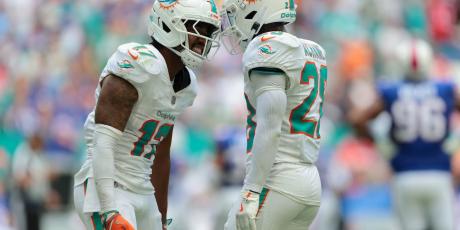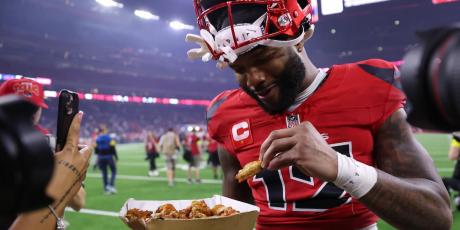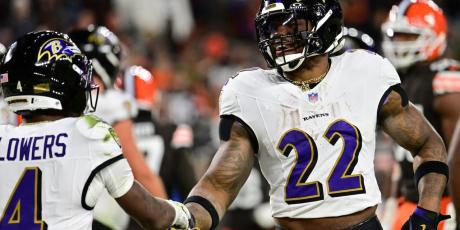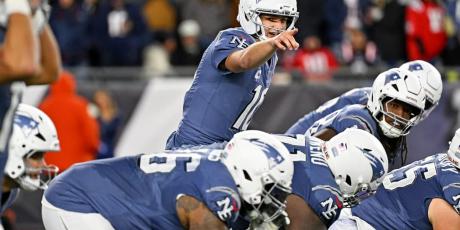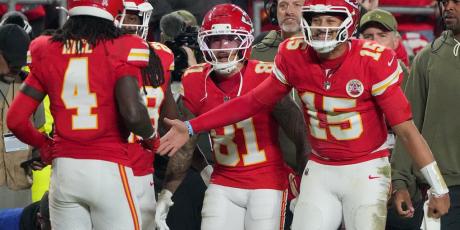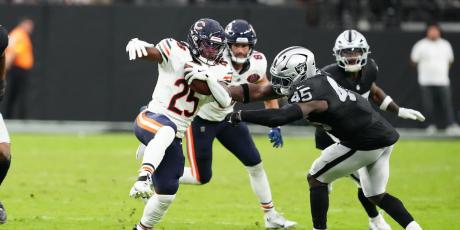Guide to DFS Bankroll Management: Game Selection

As a daily fantasy football player, the types of games you play and how much you play should be a direct reflection of your goals, bankroll strategy and level of risk aversion. Like with the other lessons in this course, rather than providing a roadmap for specific games to play, this lesson will provide an outline for how you should be thinking about the different factors of game selection, including:
- Which games fit your strategy
- When games are most profitable
- When to enter games
- How to choose buy-in levels
- Rake considerations
- Taking shots
Which Games Make Sense For You?
Choosing which games to put your money into goes back to being an effective self-evaluator. Risk-averse players aren’t going to enter the same types of games or play the same volume as someone following a fluid bankroll strategy. DFS is always evolving, and every player is different, but the general buy-in guideline has been the 80/20/10 rule. This rule refers to a bankroll strategy that puts 80 percent of your money for the week in cash games (50/50s, double ups and head-to-heads) and 20 percent of your weekly money in high volatility, large-field tournaments like GPPs and qualifiers, with your total amount of money in play for the week never exceeding 10 percent of your bankroll.
More in the DFS Bankroll Management series: Risk Management | Setting Goals
The 80/20/10 rule makes sense for a lot of players and, assuming even a slight edge in daily fantasy football, should be a bankroll strategy that will lead to profits in the long run without a huge risk of ruin. As the daily fantasy landscape evolves, marketing dollars and huge prizes are pushing both new and experienced players towards large-field, top-heavy payout tournaments.
Because a large percentage of new players are drawn to these tournaments, an argument can be made that the 80/20/10 rule should move toward a more tournament-heavy mix, maybe something like 75/25/10. If you change your cash game to tournament mix though, the overall money you play in a given week should also be adjusted. A player who opts to put 25 percent of their money in large-field tournaments might adjust the rule to 75/25/8, while a cash-game grinder might find that 85/15/12 is their optimal approach.
Gauging the skill level of your opponents, as well as your own edge, should guide your weekly mix. Given an accurate win rate, one could theoretically calculate the optimal game mix. Because the NFL season is so short and the player pool is expanding, knowing your true long-term edge is nearly impossible right now, making bankroll strategy much more of an art than a science.
When are Games Most Profitable?
When online poker was at its peak, Sundays were an absolute must-play day for serious poker players, as that’s when the biggest tournaments ran. The World Series of Poker sees thousands of poker players from around the world embark on a journey to Las Vegas every June, even if they don’t plan on playing in the tournaments. The reason is simple: the largest prizes attract the biggest concentration of “dead money” and that money trickles down to the cash games and smaller tournaments. Getting to Vegas early in the WSOP is essential if you plan to feast on the cash games. Most novice players ignore bankroll strategy and blow their money quickly. By mid-June, the poker rooms can become shark-infested waters.
Just as following around the biggest tournaments can pad your poker pockets, ramping up your DFS volume when the largest prizes are being handed out can be an intelligent way to boost your bankroll. While we don’t have the information and accurate projections available to us early in the season like we do after a month of games have been played, the first few weeks of NFL action is when new players are going to be dipping their toes in DFS waters for the first time. We want to be there to scoop up the profits while new players still have money in their bankrolls.
When to Enter Games
Even though the same game types are available throughout the week, all games are not created equal. In daily fantasy football, the time that you post or enter games can have a critical effect on your bankroll.
When it comes to GPPs, getting your entry fees in at the beginning of the week can instantly increase your expected value for the year. Sites post their low-buy-in, large-prize-pool tournaments as soon as games are posted for the week and the chance to turn $2 into $10,000 or a live qualifier usually means these games fill up quickly. The lottery nature of these tournaments invites an influx of novice players.
On the flip side, keeping an eye on GPPs right before kickoff can be a massive boost to expected value in the form of overlay. When guaranteed prize pools don’t fill, the sites are essentially giving out “free money.” What once was a 1-in-5 chance to cash, can suddenly become a 1-in-3 chance.
Entering head-to-head matchups can be a little trickier. There are various tools on every DFS site that can help newer players avoid the landmines that are the professional DFS players and serious grinders, but there are also great times to enter head-to-head matchups, namely in the hours leading up to kickoff.
Unlike serious DFS grinders, newer daily fantasy football players generally aren’t spending the entire week doing research and tweaking their bankroll strategy and game mix and therefore are logging onto DFS sites hours, or even minutes, before kickoff to set lineups and get some action on the games. This makes joining head-to-head games very close to kickoff a profitable endeavor.
When it comes to avoiding the sharks in head-to-head matchups, unless your screen name is already established as one to avoid, it’s probably best to pick up head-to-head games, rather than post them yourself. A game posted by a non-reputable player is usually quickly scooped up by a pro lurking in the lobbies. How do they know to take your game? Look for the badges.
Both FanDuel and DraftKings have implemented a badge system in recent years, indicating which players are experienced and which players aren't. Get familiar with the badge system on the site that you play on and you should easily be able to avoid the sharks. Sites often offer games that are only available to beginners or inexperienced players. If you qualify, these games can be cash cows and often offer lower rake than similar contests at the same buy-in levels, so be sure to keep an eye out for these games.
Buy-In Levels
For most daily fantasy football players, playing at the smallest buy-ins makes sense, and is probably an optimal strategy. The only way to smooth out variance is through volume, and the only way for daily fantasy football players to increase weekly volume is to enter more games. Unless you have an unlimited bankroll (If you do, why are you even reading this? Go buy an island.), playing more games means spreading your money across the smallest buy-ins until you reach a certain limit, moving up to the next buy-in limit, and so on.*
It might sound obvious, but playing 100 $1 buy-in games is going to be much lower variance than playing two $50 games with the same $100. While the upside of the latter option is higher, the downside and inevitable plunge in your cashier window far outweigh the reward. Not only is spreading money across lower buy-in levels going to help smooth variance, but it’s going to open your lineups up to exposure to inferior competition. Since there is no theoretical cap on how many games you can play at one time, start from the bottom and work your up.
*Many daily sites will cap the number of cash games that you can play at each buy-in level. The exact rules will vary by site. There is also a point where rake concerns will influence buy-in levels, but for now, that affects only very high stakes players.
Accounting for the Rake
Anyone who has ever studied DFS closely knows rake can be the ultimate bankroll killer. Even if you are the top player in the world at your level, if the rake is too high, games are unbeatable. There is a reason people often argue that low-stakes, live poker games are unbeatable (this isn't true)—if a casino is taking 10 percent of every hand off of the table in the form of rake, there could be times where a live game could see well over $100 leave the table every hour. In a game where people are barely buying in for that much, you could see why it might be hard to turn a profit.
Like in poker, rake should be a major consideration in DFS. Although the definition of a head-to-head or 50/50 means winning half of the time should result in breaking even, the rake requires a win rate over 50 percent to avoid losing money. Before playing any contest, DFS players should consider the true win rate needed to be profitable.
While GPP rake may be similar across sites and buy-in levels, pay-out structures can vary greatly from tournament to tournament. Some GPPs are very top heavy, meaning the sites pay much more to first place and a smaller percentage of players cash. Other GPPs have flatter payout structures, meaning less money to first and a higher percentage of players who cash. The latter option is lower variance than the former.
This last note is a point of major interest for newer daily fantasy players, and allocation of funds should be adjusted accordingly. In a 50/50, half of the field wins, but they do not actually double their money. A double up sees you double your money, but less than half of the field wins. This is why we often see much higher rake in double ups than in 50/50s. Because it’s virtually impossible for NFL DFS players to know their precise win rate, 50/50s are usually a better investment than double ups, even though you win less money in a 50/50 at the same buy-in level. Keeping more total money in the prize pool and having to be in the top 50 percent of the field in a 50/50 is more valuable than needing to have a lineup in the top 45 percent than a double up with a smaller prize pool might require.
Taking Shots
Everyone wants a chance at hitting a big score in one week, but more often than not, taking those shots are bankroll killers. It’s impossible to chase a Millionaire Maker on a limited bankroll whilst practicing sound bankroll strategy. There is a way to occasionally chase monster prizes while still staying within your limit. The tradeoff is higher variance, but again, there are methods to balance that.
Say Tim has a $5,000 bankroll and is going into 2018 with a strict 80/20/10 rule, but he wants to maximize his chances to win the Millionaire Maker in Week 1. Tim’s normal week would consist of $100 in GPP entries, and because he’s read this course, Tim plans on splitting that $100 across 20 $5 lineups. In Week 1, though, Tim will opt to play 5 $20 lineups in the Millionaire Maker, a strategy that obviously has a ton of upside, but is extremely high variance, especially because the Millionaire Maker pays out a lower percentage of entrants than many other DraftKings GPPs.
In order to balance the increased risk of playing fewer, high buy-in GPPs, Tim can adjust his cash game allocation. My suggestion for Tim in Week 1 would be to play more, if not all, head-to-head games and decrease volume in 50/50s and double ups.
Head-to-heads contests let players be rewarded for the true value of their lineups. Assuming a player enters enough head-to-head contests, if their lineup is in the 40th percentile of all lineups at a given buy-in level, they will win about 40 percent of their games. In 50/50s and double ups, the same 40th-percentile lineup will never cash. In a week with more variance already built into his tournament strategy, Tim should forego the upside of 50/50s and double ups for the decreased variance of head-to-head contests.
As I mentioned earlier, keeping an eye out for overlay in GPPs at a level right above your normal buy-in makes for great opportunities to take shots. These chances often come early in the NFL season when sites are offering multiple huge prizes to attract new players and they don’t fill those games.
An overly-conservative bankroll approach can cause players to miss out on taking shots. While they may never go broke, they also may never get that giant boost to their bankroll at one time. Taking shots should not be a primary concern, especially for newer DFS players. Understanding and proving to yourself that you can practice strict bankroll management should always be the goal. When opportunities do arise to take shots, though, there is a calculated way to do so.
A Final Word
My hope is that this course provided a solid foundation in how to think about daily fantasy football outside of just setting lineups. Not only is lineup-building information abundant, but it doesn’t ensure bankroll growth. Perfect lineups every week are worthless if they aren’t entered into the right games or if you are someone who will give your money right back to the community through poor bankroll management. Taking the time to figure out who you are as a player and as a person will help you draw your own DFS roadmap, and can ultimately prove to be more beneficial than any value plays report.

